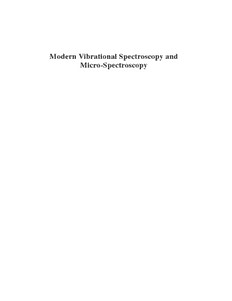
Modern Vibrational Spectroscopy and Micro-Spectroscopy PDF
Preview Modern Vibrational Spectroscopy and Micro-Spectroscopy
Modern Vibrational Spectroscopy and Micro-Spectroscopy Modern Vibrational Spectroscopy and Micro-Spectroscopy Theory, Instrumentation and Biomedical Applications MAXDIEM Northeastern University, USA Thiseditionfirstpublished2015 ©2015JohnWiley&Sons,Ltd Registeredoffice JohnWiley&SonsLtd,TheAtrium,SouthernGate,Chichester,WestSussex,PO198SQ,UnitedKingdom Fordetailsofourglobaleditorialoffices,forcustomerservicesandforinformationabouthowtoapplyforpermissiontoreusethecopyrightmaterialin thisbookpleaseseeourwebsiteatwww.wiley.com. TherightoftheauthortobeidentifiedastheauthorofthisworkhasbeenassertedinaccordancewiththeCopyright,DesignsandPatentsAct1988. Allrightsreserved.Nopartofthispublicationmaybereproduced,storedinaretrievalsystem,ortransmitted,inanyformorbyanymeans,electronic, mechanical,photocopying,recordingorotherwise,exceptaspermittedbytheUKCopyright,DesignsandPatentsAct1988,withoutthepriorpermission ofthepublisher. Wileyalsopublishesitsbooksinavarietyofelectronicformats.Somecontentthatappearsinprintmaynotbeavailableinelectronicbooks. Designationsusedbycompaniestodistinguishtheirproductsareoftenclaimedastrademarks.Allbrandnamesandproductnamesusedinthisbookare tradenames,servicemarks,trademarksorregisteredtrademarksoftheirrespectiveowners.Thepublisherisnotassociatedwithanyproductorvendor mentionedinthisbook. LimitofLiability/DisclaimerofWarranty:Whilethepublisherandauthorhaveusedtheirbesteffortsinpreparingthisbook,theymakenorepresentations orwarrantieswithrespecttotheaccuracyorcompletenessofthecontentsofthisbookandspecificallydisclaimanyimpliedwarrantiesofmerchantability orfitnessforaparticularpurpose.Itissoldontheunderstandingthatthepublisherisnotengagedinrenderingprofessionalservicesandneitherthe publishernortheauthorshallbeliablefordamagesarisingherefrom.Ifprofessionaladviceorotherexpertassistanceisrequired,theservicesofa competentprofessionalshouldbesought Theadviceandstrategiescontainedhereinmaynotbesuitableforeverysituation.Inviewofongoingresearch,equipmentmodifications,changesin governmentalregulations,andtheconstantflowofinformationrelatingtotheuseofexperimentalreagents,equipment,anddevices,thereaderisurgedto reviewandevaluatetheinformationprovidedinthepackageinsertorinstructionsforeachchemical,pieceofequipment,reagent,ordevicefor,among otherthings,anychangesintheinstructionsorindicationofusageandforaddedwarningsandprecautions.ThefactthatanorganizationorWebsiteis referredtointhisworkasacitationand/orapotentialsourceoffurtherinformationdoesnotmeanthattheauthororthepublisherendorsesthe informationtheorganizationorWebsitemayprovideorrecommendationsitmaymake.Further,readersshouldbeawarethatInternetWebsiteslistedin thisworkmayhavechangedordisappearedbetweenwhenthisworkwaswrittenandwhenitisread.Nowarrantymaybecreatedorextendedbyany promotionalstatementsforthiswork.Neitherthepublishernortheauthorshallbeliableforanydamagesarisingherefrom. LibraryofCongressCataloging-in-PublicationData Diem,Max,1947- Modernvibrationalspectroscopyandmicro-spectroscopy:theory,instrumentation,andbiomedicalapplications/MaxDiem. pagescm Includesbibliographicalreferencesandindex. ISBN978-1-118-82486-3(pbk.) 1.Spectrumanalysis–Diagnosticuse 2.Vibrationalspectra. I.Title. RC78.7.S65D542015 616.07′54–dc23 2015019354 AcataloguerecordforthisbookisavailablefromtheBritishLibrary. Setin10/12ptTimesLTStdbySPiGlobal,Chennai,India 1 2015 I would like to dedicate this book to my wife, Mary Jo, who put up with my hidingawayinmyhomeofficeformanyaneveningandmyabsentmindedness for 16 months during which this book was written. I also would liketo acknowledgethe excellent and enthusiastic crewof post- docs,graduateandundergraduatestudentsinmyresearchlaboratoryatNorth- easternUniversitywhowasresponsibleforthemajorityoftheworkpresented here (listed chronologically). Miloš, Christian, Susie, Melissa, Brian, Tatjana, Jen (I), Ben, Ellen, Kostas, Antonella, Evgenia, Erin, Jen (II), Christina, Kathleen, and Doug. Max Diem Contents Preface xv Prefaceto‘IntroductiontoModernVibrationalSpectroscopy’(1994) xix I MODERNVIBRATIONALSPECTROSCOPYANDMICRO-SPECTROSCOPY: THEORY,INSTRUMENTATIONANDBIOMEDICALAPPLICATIONS 1 I.1 HistoricalPerspectiveofVibrationalSpectroscopy 1 I.2 VibrationalSpectroscopywithinMolecularSpectroscopy 2 References 4 1 MolecularVibrationalMotion 5 1.1 Theconceptofnormalmodesofvibration 6 1.2 Theseparationofvibrational,translational,androtationalcoordinates 6 1.3 Classicalvibrationsinmass-weightedCartesiandisplacementcoordinates 7 1.4 Quantummechanicaldescriptionofmolecularvibrations 13 1.4.1 Transitionfromclassicaltoquantummechanicaldescription 13 1.4.2 Diatomicmolecules:harmonicoscillator 14 1.4.3 Diatomicmolecules:anharmonicity 19 1.4.4 Polyatomicmolecules 20 1.5 Time-dependentdescriptionandthetransitionmoment 22 1.5.1 Time-dependentperturbationofstationarystatesbyelectromagneticradiation 22 1.5.2 Thevibrationaltransitionmomentforabsorption:harmonicdiatomicmolecules 25 1.5.3 Thevibrationaltransitionmomentforabsorption:anharmonicdiatomicmolecules 27 1.5.4 Thevibrationaltransitionmomentforabsorption:polyatomicmolecules 30 1.5.5 Isotopiceffects:diatomicmolecules 31 1.6 BasicinfraredandRamanspectroscopies 32 1.6.1 Infraredabsorptionspectroscopy 32 1.6.2 Raman(scattering)spectroscopy 35 1.7 Concludingremarks 38 References 38 2 SymmetryPropertiesofMolecularVibrations 39 2.1 Symmetryoperationsandsymmetrygroups 40 2.2 Grouprepresentations 44 2.3 Symmetryrepresentationsofmolecularvibrations 50 2.4 Symmetry-basedselectionrulesforabsorptionprocesses 54 2.5 SelectionrulesforRamanscattering 56 2.6 Discussionofselectedsmallmolecules 57 2.6.1 Tetrahedralmolecules:carbontetrachloride,CCl ,andmethane,CH 57 4 4 viii Contents 2.6.2 Chloroformandmethylchloride 64 2.6.3 Dichloromethane(methylenechloride),CH Cl 67 2 2 2.6.4 Dichloromethane-d (methylenechloride-d ),CHDCl 68 1 1 2 References 69 3 InfraredSpectroscopy 71 3.1 GeneralaspectsofIRspectroscopy 71 3.2 Instrumentation 73 3.2.1 Sourcesofinfraredradiation:blackbodysources 73 3.2.2 Sourcesofinfraredradiation:quantum-cascadelasers, nonlineardevices 75 3.2.3 Transferoptics 76 3.2.4 Colorsortingdevices:monochromators 76 3.2.5 Colorencodingdevices:interferometers 79 3.2.6 Detectors 82 3.2.7 Read-outdevices 84 3.3 MethodsininterferometricIRspectroscopy 84 3.3.1 Generalinstrumentation 84 3.3.2 Opticalresolution 86 3.3.3 Zerofillingandfouriersmoothing 86 3.3.4 Phasecorrection 88 3.3.5 Apodization 91 3.4 Samplingstrategies 92 3.4.1 Transmissionmeasurement 92 3.4.2 Specularreflection 94 3.4.3 Diffusereflection 95 3.4.4 Attenuatedtotalreflection 97 3.4.5 Infraredreflectionabsorptionspectroscopy(IRRAS) 99 3.4.6 Fouriertransformphotoacousticspectroscopy(FT-PAS) 100 3.4.7 Planararrayinfraredspectroscopy(PA-IRS) 101 3.4.8 Two-dimensionalFTIR 101 3.4.9 Infraredmicrospectroscopy 102 References 102 4 RamanSpectroscopy 103 4.1 GeneralaspectsofRamanspectroscopy 104 4.2 Polarizability 105 4.3 PolarizationofRamanscattering 107 4.4 Dependenceofdepolarizationratiosonscatteringgeometry 111 4.5 AcomparisonbetweenRamanandfluorescencespectroscopy 114 4.6 InstrumentationforRamanspectroscopy 116 4.6.1 Sources 116 4.6.2 DispersiveRamaninstrumentationandmultichanneldetectors 116 4.6.3 InterferometricRamaninstrumentation 121 4.6.4 Ramanmicrospectroscopy 122 References 122 Contents ix 5 ADeeperLookatDetailsinVibrationalSpectroscopy 123 5.1 Fermiresonance 124 5.2 Transitiondipolecoupling(TDC) 128 5.3 Groupfrequencies 129 5.4 Rot-vibrationalspectroscopy 130 5.4.1 Classicalrotationalenergy 130 5.4.2 Quantummechanicsofrotationalspectroscopy 132 5.4.3 Rot-vibrationaltransitions 137 References 141 6 SpecialRamanMethods:Resonance,Surface-Enhanced,andNonlinear RamanTechniques 143 6.1 ResonanceRamanspectroscopy 144 6.2 Surface-enhancedRamanscattering(SERS) 146 6.3 NonlinearRamaneffects 149 6.3.1 Spontaneous(incoherent)nonlinearRamaneffects 149 6.3.2 Coherentnonlineareffects 152 6.4 Continuouswaveandpulsedlasers 159 6.4.1 Einsteincoefficientsandpopulationinversion 160 6.4.2 Operationofagaslaser 162 6.4.3 Principlesofpulsedlasers 163 6.4.4 Operationofpulsedlasers 163 6.5 Epilogue 164 References 164 7 Time-ResolvedMethodsinVibrationalSpectroscopy 167 7.1 Generalremarks 167 7.2 Time-resolvedFTinfrared(TR-FTIR)spectroscopy 168 7.2.1 Experimentalaspects 168 7.2.2 ApplicationsofTR-FTIRspectroscopy 169 7.3 Time-resolvedRamanandresonanceRaman(TRRR)spectroscopy 171 7.3.1 Instrumentalaspects 171 7.3.2 ApplicationsofTRRR 173 7.3.3 Hemegroupdynamicstudies 173 7.3.4 Rhodopsinstudies 174 References 175 8 VibrationalOpticalActivity 177 8.1 Introductiontoopticalactivityandchirality 177 8.2 Infraredvibrationalcirculardichroism(VCD) 179 8.2.1 Basictheory 179 8.2.2 Excitontheoryofopticalactivity 180 8.3 ObservationofVCD 181 8.4 ApplicationsofVCD 185 8.4.1 VCDofbiologicalmolecules 185 8.4.2 SmallmoleculeVCD 185 x Contents 8.5 Ramanopticalactivity 186 8.6 ObservationofROA 188 8.7 ApplicationsofROA 189 8.7.1 ROAofbiologicalmolecules 189 8.7.2 SmallmoleculesROA 190 References 190 9 ComputationofVibrationalFrequenciesandIntensities 193 9.1 Historicalapproachestothecomputationofvibrationalfrequencies 193 9.2 Vibrationalenergycalculations 194 9.2.1 Classicalapproaches:theWilsonGFmatrixmethod 194 9.2.2 Earlycomputer-basedvibrationalanalysis 197 9.3 Abinitioquantum-mechanicalnormalcoordinatecomputations 197 9.4 Vibrationalintensitycalculations 198 9.4.1 Fixedpartialchargemethodforinfraredintensities 198 9.4.2 QuantummechanicalinfraredandRamanintensities:localizedmolecularorbitals 200 9.4.3 Thefiniteperturbationmethod 200 References 202 II BIOPHYSICALANDMEDICALAPPLICATIONSOFVIBRATIONAL SPECTROSCOPYANDMICROSPECTROSCOPY 203 10 BiophysicalApplicationsofVibrationalSpectroscopy 205 10.1 Introduction 205 10.2 Vibrationsofthepeptidelinkageandofpeptidemodels 206 10.2.1 Aminoacidsandthepeptidelinkage 206 10.2.2 Thevibrationalmodesofthepeptidelinkage 206 10.3 Conformationalstudiesofpeptidesandpolyaminoacids 210 10.4 Proteinspectroscopy:IR,VCD,Raman,resonanceRaman,andROAspectraofproteins 215 10.5 Nucleicacids 219 10.5.1 Structureandfunctionofnucleicacids 219 10.5.2 Phosphodiestervibrations 222 10.5.3 Ribosevibrations 222 10.5.4 Basevibrations 222 10.6 ConformationalstudiesonDNAandDNAmodelsusingIR,Raman,andVCDspectroscopies 223 10.7 Lipidsandphospholipids 227 10.8 Epilogue 231 References 231 11 VibrationalMicrospectroscopy(MSP) 235 11.1 Generalremarks 235 11.2 Generalaspectsofmicroscopy 236 11.3 Ramanmicrospectroscopy(RA-MSP) 239 11.3.1 Dispersive(singlepoint)systems 240 11.3.2 Micro-Ramanimagingsystems 241 Contents xi 11.4 CARSandFSRSmicroscopy 242 11.5 Tip-enhancedRamanspectroscopy(TERS) 243 11.6 Infraredmicrospectroscopy(IR-MSP) 243 11.6.1 Fourier-transforminfraredimagingsystems 244 11.6.2 QCL-basedsystems 246 11.7 Samplingstrategiesforinfraredmicrospectroscopy 247 11.7.1 Transmissionmeasurement 247 11.7.2 Transflectionmeasurement 247 11.7.3 Attenuatedtotalreflection(ATR) 248 11.8 Infrarednear-fieldmicroscopy 249 References 249 12 DataPreprocessingandDataProcessinginMicrospectralAnalysis 251 12.1 Generalremarks 251 12.2 Datapreprocessing 252 12.2.1 Cosmicrayfiltering(Ramandatasetsonly) 253 12.2.2 Linearwavenumberinterpolation(Ramandatasetsonly) 253 12.2.3 Conversionfromtransmittancetoabsorbanceunits(someinfrareddatasets) 253 12.2.4 Normalization 253 12.2.5 Noisereduction 254 12.2.6 Conversionofspectratosecondderivatives 256 12.3 Reductionofconfoundingspectraleffects 257 12.3.1 Reductionofwatervaporcontributionsincellularpixelspectra 258 12.3.2 MieandresonanceMiescattering 258 12.3.3 Correctionofdispersivebandshapes 260 12.3.4 Standingwaveeffect 262 12.4 Unsupervisedmultivariatemethodsofdatasegmentation 263 12.4.1 Factormethods 264 12.4.2 Datasegmentationbyclusteringmethods 269 12.5 Supervisedmultivariatemethods 272 12.5.1 Discussionofsensitivity,specificity,andaccuracy 272 12.5.2 Softindependentmodelingofclassanalogy(SIMCA) 273 12.5.3 Artificialneuralnetworks(ANNs) 274 12.5.4 Supportvectormachines(SVMs) 275 12.5.5 Randomforests(RFs) 276 12.5.6 Cross-validation 277 12.6 Summaryofdataprocessingformicrospectralanalysis 278 12.7 Two-dimensionalcorrelationmethodsininfraredspectroscopy(2D-IR) 278 References 280 13 InfraredMicrospectroscopyofCellsandTissueinMedicalDiagnostics 283 13.1 Introduction 283 13.2 Spectralhistopathology(SHP) 284 13.2.1 Reviewofclassicalhistopathology 284 13.2.2 Spectralmethodsinhistopathology 285 13.2.3 Infraredabsorptionspectroscopyofcellsandtissue:introductorycomments 285 xii Contents 13.3 MethodologyforSHP 287 13.3.1 Generalapproach 287 13.3.2 Sequenceofstepsinclassicalhistopathology 288 13.3.3 Sequenceofstepsforspectralhistopathology 288 13.4 ApplicationsofSHPfortheclassificationofprimarytumors 294 13.4.1 Cervicaltissueandcervicalcancer 294 13.4.2 Lungcancer 298 13.4.3 Prostatecancer 303 13.4.4 Breastcancer 304 13.5 ApplicationofSHPtowardthedetectionandclassificationofmetastatictumors 304 13.5.1 Detectionofcoloncancermetastasesinlymphnodes 304 13.5.2 Detectionofbreastcancermetastasesinlymphnodes 306 13.5.3 Detectionandclassificationofbrainmetastases 307 13.6 FutureprospectsofSHP 309 13.7 Infraredspectralcytopathology(SCP) 310 13.7.1 Classicalcytopathology 311 13.7.2 Spectralcytopathology 314 13.7.3 MethodsforSCP 314 13.8 SCPresults 316 13.8.1 EarlyresultsofSCP 316 13.8.2 Fixationstudies 317 13.8.3 Spectralcytopathologyofcervicalmucosa 320 13.8.4 Spectralcytopathologyoftheoralmucosa 323 13.8.5 Spectralcytopathologyofesophagealcells 326 13.9 SCPofculturedcells 328 13.9.1 EarlySCPeffortsandgeneralresults 328 13.9.2 SCPofculturedcellstostudytheeffectsofthecellcycleandofdrugsoncells 328 13.10 Infraredspectroscopyofcellsinaqueousmedia 331 13.11 FuturepotentialofSCP 333 References 333 14 RamanMicrospectroscopyofCellsandTissueinMedicalDiagnostics 339 14.1 Introduction 339 14.2 ExperimentalConsiderationforRamanMicrospectroscopy 341 14.3 High-ResolutionRamanSpectralCytopathology 343 14.3.1 Subcellularorganization 343 14.3.2 Subcellulartransportphenomena 345 14.4 Low-ResolutionRamanSCPofCulturedCellsInVitro 349 14.5 RamanSCPinSolution 352 14.5.1 Opticaltweezingofcellsinaqueousmedia 352 14.5.2 Cellstrappedinmicrofluidicchips 353 14.5.3 ResonanceRamanspectroscopyoferythrocytes 353 14.6 RamanSpectralHistopathology(RaSHP) 354 14.7 InVivoRamanSHP 356 14.8 DeepTissueRamanSHP 357 14.8.1 Hardtissuediagnostics 357
